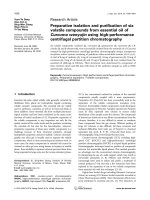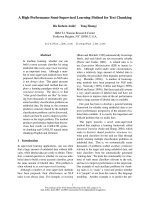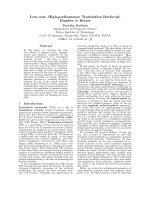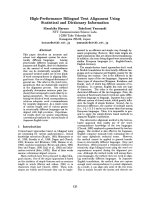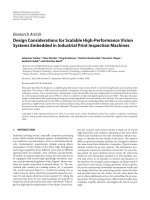HIGH PERFORMANCE CONCRETE STRUCTURAL DESIGNERS’ GUIDE
Bạn đang xem bản rút gọn của tài liệu. Xem và tải ngay bản đầy đủ của tài liệu tại đây (1.65 MB, 128 trang )
0
HIGH PERFORMANCE CONCRETE
STRUCTURAL DESIGNERS’ GUIDE
by the High Performance Concrete Technology Delivery Team
First Edition
March 2005
Disclaimer
This document is disseminated under the sponsorship of the U.S. Department of Transportation,
Federal Highway Administration in the interest of technical information exchange. The
U.S. Government assumes no liability for its contents or use thereof. The contents of this Guide
reflect the views of the authors of each Section, who are responsible for the accuracy of the
information presented herein. The contents do not necessarily reflect the official policy of the
U.S. Department of Transportation. This Guide does not constitute a standard, specification or
regulation.
Substantial effort has been made to assure that all of the data and information in this HPC Designers’
Guide are accurate and useful to the designers in considering high performance concrete in their bridge
projects. This should not be considered as an official document for guidance on design and fabrication.
The data and information may change with time. The designers must verify the accuracy and
appropriateness of the data and information before finalizing the design and specifications. Although
this Guide is intended for use by designers competent in the design of highway bridges, the team
leaders, supervisors, and managers of bridge engineering, and the general readers may also find the
Guide helpful in gaining better understanding of the properties and benefits of high performance
concrete.
HIGH PERFORMANCE CONCRETE
STRUCTURAL DESIGNERS’ GUIDE
by the High Performance Concrete Technology Delivery Team
i
HIGH PERFORMANCE CONCRETE
STRUCTURAL DESIGNER’S GUIDE
T A B L E O F C O N T E N T S
Title Page
Orientation 1
Acronyms 4
SECTION 1: OBJECTIVE AND SCOPE 7
SECTION 2: INTRODUCTION 9
SECTION 3: DEFINITION AND CHARACTERISTICS 11
3.1 Introduction 11
3.2 Definition 11
3.3 Material and Performance Characteristics 11
3.4 References 12
SECTION 4: RESEARCH 15
4.1 Introduction 15
4.2 Ultra High Performance Concrete (UHPC)
Research Program at FHWA 15
4.3 Rapid Migration Test 20
4.4 References 22
SECTION 5: STRUCTURAL DESIGN AND SPECIFICATIONS 23
FOR HIGH STRENGTH CONCRETE
5.1 Introduction 23
5.2 Cost Effective Designs 23
5.3 Material Properties 24
5.4 Flexure 29
5.5 Shear and torsion 32
5.6 Deformations, delineations, and Camber 32
5.7 References 32
SECTION 6: HIGH PERFORMANCE CONCRETE (HPC) MIX 35
DESIGN AND PROPORTIONING
6.1 Introduction 35
6.2 Advantages of High Performance 35
Concrete in Highway Bridges 35
6.3 Mixture Proportioning I 37
6.4 Mixture Proportioning – Advanced Concepts 40
6.5 Selection of Materials Proportions 41
6.6 Specification Requirements for Strength 46
and Durability
6.7 Conclusion 47
6.8 References 47
ii
SECTION 7: PRECAST/PRESTRESSED BEAM FABRICATION,
TRANSPORTATION AND ERECTION 49
7.1 Introduction 49
7.2 Fabrication 49
7.3 Transportation and Erection 56
7.4 Bearings 58
7.5 References 58
SECTION 8: CAST-IN-PLACE CONSTRUCTION 59
8.1 Introduction 59
8.2 Preparation for C & P Construction 59
8.3 Batching & Mixing 62
8.4 Handling & Placement 63
8.5 Finishing 64
8.6 Curing 66
8.7 Conclusions 70
8.8 References 70
SECTION 9: BRIDGE INSTRUMENTATION 71
9.1 Introduction 71
9.2 Instrumentation Program 72
9.3 Examples 73
9.4 References 74
SECTION 10: COSTS 75
10.1 Introduction 75
10.2 Types of Cost Estimate 75
10.3 Life-Cycle Cost 78
10.4 Initial and Long-term Cost Savings 80
10.5 Preliminary Design and Cost Estimate 81
10.6 Final Plans, Specifications, and Cost Estimate 82
10.7 Cost Data from State HPC Projects 82
10.8 References 84
SECTION 11: CASE STUDIES AND LESSONS LEARNED 85
11.1 Introduction 85
11.2 Outline for Case Studies 85
11.3 Lessons Learned from HPC Projects 86
11.4 Project Listings 87
11.5 References 109
SECTION 12: ACKNOWLEDGEMENTS 111
APPENDIX A: SAMPLE RESEARCH STATEMENTS 113
APPENDIX B: LIFE CYCLE COST ANALYSIS 116
1
ORIENTATION
High Performance Concrete
Technology Delivery Team
Introducing . . .
the Federal Highway Administration’s
HIGH PERFORMANCE CONCRETE
TECHNOLOGY DELIVERY TEAM
Created to implement a mandate of the Intermodal Surface Transportation Efficiency Act of
1991 (ISTEA) legislation, the Federal Highway Administration’s (FHWA) High Performance
Concrete Technology Delivery Team (HPC TDT) motivated and helped State DOT’s to build
more economical and durable bridges using high performance concrete. The TDT, created in
1997, assisted 13 States in design and construction of
HPC bridges. Hundreds of State, Federal and industry
personnel were introduced to HPC technology at
workshops and showcases planned by the TDT and
hosted by participating DOT’s. Working with the American
Association of State Highway and Transportation Officials
(AASHTO) Lead States Team on HPC Implementation, the
TDT influenced many additional State DOT’s to try HPC in
their highway bridges.
By the time the ISTEA legislation expired, about 25 States had used HPC. Today, the TDT
continues to promote HPC and encourage states to build HPC bridges through the Innovative
Bridge Research & Construction Program (IBRCP) created under the current highway program
of TEA-21. HPC is considered an innovative material and projects can be funded under the
guidelines of the IBRCP.
Two primary factors led to the rejuvenation of the HPC TDT. In 1998, the FHWA created
Resource Center offices in Atlanta, Baltimore, Olympia Fields (IL), and San Francisco. These
Centers were staffed to bring training, technical expertise and technology transfer specialists
closer to state and local highway agencies. In addition, the TDT was being renewed with a
focus on field delivery of HPC technology. Accordingly, TDT members represent the FHWA
Resource Center; the Division Offices; the Agency’s Headquarters Offices of Bridge and
Pavement Technology; the Office of Infrastructure Research and Development; the Eastern
Federal Lands Highway Division; and various State DOT’s. Recognizing that earlier
technology delivery efforts were the result of key partnerships and coordination, the new TDT
also includes representatives from academia and industry.
One major initiative aimed at achieving our goal to educate users involves use of the
world wide web, where a new “community of practice” website has been established.
The site allows users to post questions on HPC, participate in discussions, share
documents, and review works in progress. Visit the site at
/>
2
Users will have the option to subscribe to an e-mail notification system where they will
receive a summary of postings to the Community of Practice site for any of the following
HPC subject areas that they choose:
• Definition and Research
• Structural Design/Specifications
• Mix Design/Proportioning
• Precast/Prestressed Beam Fabrication/
Transportation/Erection
• Cast-in-Place Construction
• Instrumentation/Monitoring/Evaluation
• Costs
• Case Studies/Lessons Learned
A new link has been added to results of a 2003-04 national survey on State DOT HPC
implementation.
The focus of the new HPC TDT is to be the leader in advancing HPC technology for the
benefit of our Nation’s infrastructure. The business plan includes:
VISION:
“Be the leader in advancing HPC technology”
MISSION:
“Improve the durability and cost-effectiveness of the
Nation’s transportation infrastructure”
GOALS:
1) Establish HPC as standard practice for every State DOT
2) Partner with AASHTO and Industry to develop and lead a
National agenda on HPC technology
3) Implement the AASHTO HPC Lead States’ Team transition
plan
4) Educate users on HPC practices in design, construction, and
materials
3
To request more information about the HPC TDT
contact the Web Administrator:
LOU TRIANDAFILOU (410) 962-3648
FHWA Resource Center
Or, other HPC TDT Members:
FHWA FIELD OFFICE CONTACTS
MATTHEW GREER DOUG EDWARDS EDWARD PARKER
(720) 963-3008 (404) 562-3673 (404) 562-3643
Colorado Division Office FHWA Resource Center Georgia Division Office
RICH PAKHCHANIAN FRANK RICH CLAUDE NAPIER
(703) 404-6246 (402) 437-5967 (804) 775-3363
Federal Lands Highways Nebraska Division Office Virginia Division Office
MICHAEL PRAUL TOM SAAD JEFF SMITH
(207) 622-8350 x109 (708) 283-3521 (404) 562-3905
Maine Division Office FHWA Resource Center FHWA Resource Center
FHWA HEADQUARTERS CONTACTS
GARY CRAWFORD JOSEPH HARTMANN JON MULLARKY
(202) 366-1286 (202) 493-3059 (202) 366-6606
Office of Pavement Technology Office of Infrastructure R&D Office of Pavement Technology
JERRY POTTER MYINT LWIN
(202) 366-4596 (202) 366-4589
Office of Bridge Technology Office of Bridge Technology
STATE DOT, INDUSTRY and ACADEMIA CONTACTS
MICHAEL BERGIN SHRI BHIDE PAUL TIKALSKY
(352) 955-6666 (847) 972-9100 (814) 863-5615
Florida DOT National Concrete Bridge Council Penn State University
DONALD STREETER CELIK OZYILDIRIM Madhwesh Raghavendrachar
(518) 457-4593 (434) 293-1977 (916) 227-7116
New York State DOT Virginia Transportation Caltrans
Research Council
KEVIN PRUSKI
(512) 416-2306
October 22, 2004
(Texas DOT)
FHWA Pub. No. FHWA-ERC-02-006
4
ACRONYMS
AASHTO – American Association of State Highway and Transportation Officials
ACI – American Concrete Institute
ASR – Alkali-silica reactivity
ASTM – American Society of Testing and Materials
BLCCA – Bridge Life Cycle Cost Analysis
BMS – Bridge management system
CD – compact disk
C.I.P. – cast-in-place
CTH – Chloride Test, Hardened
CTL – Construction Technology Laboratories
DOT – Department of Transportation
E
c
– modulus of elasticity (also MOE)
f
’
c
– concrete compressive strength
F
r
– modulus of rupture (also MOR)
FC – future cost
FHWA – Federal Highway Administration
HPC – High Performance Concrete
HRWR – High range water reducer
HSC – High Strength Concrete
IC – initial construction
LCCA – Life Cycle Cost Analysis
LRFD – Load and Resistance Factor Design
5
NCHRP – National Cooperative Highway Research Program
NIST – National Institute of Standards and Technology
NSC – Normal strength concrete
OM&R – Operations, maintenance, repair and rehabilitation
PCA – Portland Cement Association
PCC – Portland Cement Concrete
PCI – Precast/Prestressed Concrete Institute
PONTIS – AASHTOWare BMS support tool for bridge maintenance, repairs,
rehabilitiation and replacement
PV – Present value
QC/QA – Quality Control/Quality Assurance
RCPT – Rapid Chloride Permeability Test
RMT – Rapid Migration Test
SCC – Self-consolidating concrete
SHA – State Highway Agency (ies)
SHRP – Strategic Highway Research Program
TS & L – Type, size and location
U&TP – User and third party
UHPC – Ultra high performance concrete
w – unit weight
w/cm – water-cementitious materials ratio
WSDOT – Washington State DOT
6
7
SECTION 1
OBJECTIVE AND SCOPE
by Myint Lwin, P.E., FHWA and Lou Triandafilou, P.E., FHWA
1.1 Objective
The main objective of this High Performance Concrete (HPC) Structural Designers’ Guide,
referred to as the “Designers’ Guide” throughout, is to provide a source of information to
structural designers for the design and construction of highway bridges and related structures
using HPC. This Guide will be updated periodically to keep pace with the latest developments
in HPC, particularly as the American Association of State Highway and Transportation Officials
(AASHTO) and industry organizations including the American Concrete Institute (ACI), the
Precast/Prestressed Concrete Institute (PCI), the Portland Cement Association (PCA), the
National Concrete Bridge Council (NCBC), the Post-Tensioning Institute (PTI), the American
Segmental Bridge Institute (ASBI), etc. modify their codes or guide specifications to reflect new
research findings and construction experiences.
1.2 Scope
The scope of the Designers’ Guide is fairly comprehensive. It addresses all basic aspects of
developing and producing HPC with desirable and beneficial characteristics for the
transportation community.
Section 2 introduces the topic of HPC implementation in the United States highway
infrastructure and provides historical context of this development. Section 3 addresses the
characteristics and grades of HPC for various applications and environment. Section 4 is
devoted to recently- completed national research and ongoing testing into the next generation of
HPC, along with web links to State Department of Transportation research reports. Section 5
highlights material properties of HPC that are important to owners and designers in assuring
long-term structural performance. Section 6 provides guidelines for developing HPC mix
designs and proportioning of materials.
Section 7 focuses on the fabrication, transportation and erection of precast, prestressed HPC
beams. Section 8 applies to HPC cast-in-place construction in substructures and
superstructures, with special attention to the construction of bridge decks. Section 9 identifies
the most common instruments that can be used for field measurement and recording of strain,
deflection, rotation, acceleration and temperature of HPC members. Section 10 provides cost
information and methods for assessing the cost-effectiveness of HPC with guidelines for
estimating initial construction cost and life-cycle cost. Finally, Section 11 provides an overview
of several HPC projects across the U.S. with lessons learned and contact information or web
links for further details.
8
9
SECTION 2
INTRODUCTION
by Myint Lwin, P.E. , FHWA and Lou Triandafilou, P.E., FHWA
2.1 The Beginning and Advancement
For over ten years, the international community has taken great strides with implementing High
Performance Concrete (HPC) technology in an effort to extend the service life of pavements and
bridges. Forty-five U.S. Departments of Transportation, the District of Columbia, Puerto Rico
and several Federal agencies responded to a recent survey that they have incorporated HPC
specifications in projects involving either bridge decks, superstructures and/or substructures
(See enclosed map). These projects took advantage of either the high strength or high
durability attributes of HPC, or both.
The term HPC is used to describe concretes that are made with carefully selected high quality
ingredients, optimized mixture designs, and which are batched, mixed, placed, consolidated and
cured to the highest industry standards. Typically, HPC will have a water-cementitious
materials ratio (w/cm) of 0.4 or less. Achievement of these low w/cm concretes often depends
on the effective use of admixtures to achieve high workability, another common characteristic of
HPC mixes.
Several definitions have emerged over the years to acquaint the engineering community and
concrete industry with HPC. According to ACI, HPC is defined as concrete meeting special
combinations of performance and uniformity requirements that cannot always be achieved
routinely using conventional constituents and normal mixing, placing and curing practices. The
Federal Highway Administration (FHWA) promoted HPC in the 1990’s by defining it in 1996
using four durability and four strength parameters. Associated with each definition parameter
were performance criteria, testing criteria, testing procedures to measure performance, and
recommendations to relate performance to adverse field conditions (per Cook, Goodspeed and
Vanikar). More recently, the National Concrete Bridge Council has drafted a definition for HPC
as, “…concrete that attains mechanical, durability or constructability properties exceeding those
of normal concrete.” Section 3 of this Designers’ Guide provides information relative to the
current definition and performance characteristics of HPC.
Regardless of the definition, HPC is an advancement in concrete technology that has become
commonplace and the state-of-the-practice, rather than the exception to the rule. It has
provided transportation departments a construction material with characteristics engineered to
ensure satisfactory performance throughout its intended service life.
10
11
SECTION 3
DEFINITION AND CHARACTERISTICS
by Celik Ozyildirim, P.E., Virginia DOT, Jerry Potter, P.E., FHWA and
Don Streeter, P.E., New York State DOT
3.1 Introduction
In response to the need to extend service life and to construct cost-effective structures, FHWA
has been promoting HPC. For a clear understanding of HPC, the FHWA has prepared a
definition of HPC, based on long-term performance criteria. The HPC definition is expected to
stimulate the use of higher quality concrete in highway structures. The proposed definition
consists of durability and strength parameters. Associated with each definition parameter are
performance criteria, testing procedures to measure performance and recommendations to
relate performance to adverse field conditions.
3.2 Definition
HPC is defined by the American Concrete Institute as concrete that meets special combinations
of performance and uniformity requirements that cannot always be achieved routinely using
conventional constituents and normal mixing, placing, and curing practices (ACI 116R). Section
2 of this Designers’ Guide references other definitions that have emerged for HPC.
3.3 Material and Performance Characteristics
Different characteristics of concrete in the fresh and hardened states affect performance. In the
fresh state, flowability is an important characteristic. It describes the ease or difficulty of placing
the concrete depending on the equipment available. The adequacy of flow for a specific job will
affect the quality of the finished product. Concrete with high flowability is easy to place and
facilitates the removal of undesirable air voids in concrete. In fact, self-consolidating concrete
(SCC) is available that flows through heavily reinforced areas or demanding places and
consolidates under its own mass. Well-consolidated concretes (either through mechanical
vibration or mix design, as in SCC) are essential in achieving low permeability for long-lasting
structures. The important characteristics of concrete in the hardened state mainly relate to
durability and structural design.
The performance characteristics related to durability include freeze-thaw resistance, scaling
resistance, abrasion resistance, chloride ion penetration, alkali-silica reactivity, and sulfate
resistance. The four structural design characteristics are compressive strength, modulus of
elasticity, shrinkage, and creep. The characteristics are determined using standard test
procedures, and grades of performance are suggested for each characteristic. Durability is of
utmost importance for structures exposed to the environment and concrete for each structure
may need one or more of these characteristics.
The material characteristics and grades should be selected in accordance with the intended
application and the concrete’s environment. For example, a bridge deck supported on girders
needs a specified compressive strength but is unlikely to require specified values for modulus of
elasticity and creep. It is not necessary to require all performance characteristics for a given
application. Grades of performance characteristics for high performance structural concrete are
given in Table 3-1.
12
Other important features of HPC are uniformity and consistency. With high variability, the
concrete has a high potential for not meeting the specifications.
3.4 References
1. Compilation and Evaluation of Results from High Performance Concrete Bridge Projects
by H. G. Russell, R. A. Miller, H. C. Ozyildirim, and M. K. Tadros. The report also
includes test procedures and examples of characteristics specified and achieved in
different states.
2. High Performance Concrete Defined for Highway Structures by Goodspeed, C.H.,
Vanikar, S., and Cook, R, Concrete International, Vol. 18, No. 2, February 1996, pp. 62-
67
13
Table 3-1. Grades of performance characteristics for high performance structural concrete
1
FHWA HPC performance characteristic grade
3
Performance characteristic
2
Standard test
method
1 2 3
Freeze-thaw durability
4
(F/T=relative dynamic modulus
of elasticity after 300 cycles)
AASHTO T 161
ASTM C 666
Proc. A
70%<F/T<80% 80%<F/T<90% 90%<F/T
Scaling resistance
5
(SR=visual rating of the surface
after 50 cycles)
ASTM C 672 3.0>
SR>2.0 2.0>SR>1.0 1.0>SR>0.0
Abrasion resistance
6
(AR=avg. depth of wear in mm)
ASTM C 944 2.0>AR>
1.0 1.0>AR>0.5 0.5>AR
Chloride penetration
7
(CP=coulombs)
AASHTO T 277
ASTM C 1202
2500>
CP>1500 1500>CP>500 500>CP
Alkali-silica reactivity
(ASR=expansion at 56 d) (%)
ASTM C 441 0.20>
ASR>0.15 0.15>ASR>0.10 0.10>ASR
Sulfate Resistance
(SR=expansion) (%)
ASTM C 1012
SR<
0.10
at 6 months
SR<0.10
at 12 months
SR<0.10
at 18 months
Flowability
(SL=slump, SF=slump flow)
AASHTO T 119
ASTM C 143, and
proposed slump
flow test
SL>190 mm
(SL>7-1/2 in), and
SF<500 mm
(SF<20 in)
500<
SF<600 mm
(20<
SF<24 in)
600 mm<SF
(24 in<SF)
Strength
8
(f'
c
=compressive strength)
AASHTO T 22
ASTM C 39
55<
f'
c
<69 MPa
(8<
f'
c
<10 ksi)
69<
f'
c
<97 MPa
(10<
f'
c
<14 ksi)
97 MPa<
f'
c
(14 ksi<
f'
c
)
Elasticity
9
(E
c
=modulus of elasticity)
ASTM C 469
34<
E
c
<41 GPa
(5<
E
c
<6x10
6
psi)
41<
E
c
<48 GPa
(6<
E
c
<7x10
6
psi)
48 GPa<
E
c
(7x10
6
psi<E
c
)
Shrinkage
10
(S=microstrain)
AASHTO T 160
ASTM C 157
800>S>
600 600>S>400 400>S
Creep
11
(C=microstrain/pressure unit)
ASTM C 512
75>
C>55/MPa
(0.52>
C>0.38/psi)
55>
C>30/MPa
(0.38>
C>0.21/psi)
30/MPa>
C
(0.21/psi>
C)
1 This table does not represent a comprehensive list of all characteristics that good concrete should exhibit. It does
list characteristics that can quantifiably be divided into different performance groups. Other characteristics should be
checked. One characteristic is sufficient for classification as an HPC.
2 For non-heat cured products, all tests to be performed on concrete samples moist, submersion, or match cured for 56
days or until test age. For heat cured products, all tests to be performed on concrete samples cured with the member or
match cured until test age. See table 13 of the Henry Russell report for additional information and exceptions, or Table
2 in the FHWA publication located at />
3 A given HPC mix design is specified by a grade for each desired performance characteristic. A higher grade number
indicates a higher level of performance. Performance characteristics and grades should be selected for the particular
project. For example, a concrete may perform at grade 3 in strength and elasticity, grade 2 in shrinkage and scaling
resistance, and grade 2 in all other categories.
4 Based on SHRP C/FR-91-103, p. 3.52.
5 Based on SHRP S-360.
6 Based on SHRP C/FR-91-103.
7 Based on PCA Engineering Properties of Commercially Available High-Strength Concretes, RD104
8 Use lower strengths for decks and substructures
9 Based on SHRP C/FR-91-103, p. 3.17. Modulus of elasticity is related to strength and if a lower strength is specified
for decks, the MOE should be proportionally lower. See AASHTO LRFD Bridge Design Specifications, Article 5.4.2.4.
10 Based on SHRP C/FR-91-103, p. 3.25.
11 Based on SHRP C/FR-91-103, p. 3.30.
14
15
SECTION 4
RESEARCH
by Ben Graybeal, P.E., PSI, Inc.; Joseph Hartmann, P.E., FHWA; and
Marcia Simon; FHWA
4.1 Introduction
During the past decade, the FHWA and State DOTs have performed and overseen the
completion of many research projects that have contributed to the implementation of HPC.
Several areas of the AASHTO bridge design and construction specifications have been updated
based on successful research and the advancement of High Performance Concrete (HPC)
state-of-the-art technology. Two research areas have the potential for reaping many benefits of
HPC technology. These are ultra-high performance concrete (UHPC) and the rapid migration
test (RMT) for evaluating chloride penetration resistance.
One form of UHPC is a steel fiber-reinforced concrete consisting of an optimized gradation of
fine powders and a very low water/cementitious materials ratio. Compressive strength testing
has produced results ranging from 18 ksi to 28 ksi. Tensile strengths have ranged from 0.9 to
1.7 ksi, also depending on the curing procedure. Rapid chloride penetration results have
ranged from extremely low to very low, and freeze-thaw and scaling values indicate that UHPC
exhibits enhanced durability to resist environmental attack.
The RMT is capable of providing results on HPC cylinders within 3 to 7 days. This new test
answers some of the criticisms of the current rapid chloride permeability test (RCPT) method
(AASHTO T277/ASTM C1202). It is less affected by the presence of conductive ions than the
RCPT, the applied voltage is generally lower so there is no temperature increase during testing,
and the depth of chloride ion penetration is measured. Test results can also be used to
calculate diffusion coefficients as inputs to service life and life-cycle cost models.
This section of the Guide will explore in more detail the current status of these two research
efforts. Also, the Reference subsection contains a partial listing of State DOT websites where
additional HPC-related research reports may be accessed. Other State DOTs, the FHWA, or
the Transportation Research Board may be contacted for additional reports.
4.2 Ultra High Performance Concrete (UHPC) Research Program at FHWA
The ongoing research into UHPC at FHWA can be divided into four phases as subsequently
described.
4.2.1 Phase 1: AASHTO Type II Girder Testing
The first phase of the research into UHPC focused on determining the structural behavior of the
AASHTO Type II prestressed girder. The prestressed girders tested contained no mild steel
reinforcement and were composed of a fiber reinforced UHPC. The testing focused on
determining the flexural and shear behavior from initial loading through failure. The results of
these tests indicated that UHPC exhibits some remarkable structural properties.
16
Photo 4.2.1.2 – UHPC
Shear Test at FHWA Turner
Fairbank Highway
Research Center
Photo 4.2.1.1 – UHPC
Flexure Test at Turner-
Fairbank Highway
Research Center
17
4.2.2 Phase 2: UHPC Material Characterization
In order to make efficient use of UHPC in highway bridges, a full suite of material testing was
undertaken to fully characterize the behavior of UHPC. Provided below is a listing of the testing
that has been completed or is currently underway.
4.2.2.1.1 Material:
• As supplied by Lafarge
• ½” long steel fibers
• 200 MPa compressive strength with steam cure
4.2.2.2 Time Table:
• Tests started Summer 2002, most testing to be completed by Early ‘04
o Creep and shrinkage tests are a notable exception as they
did not start until mid-2003 and will not be completed until
mid-2004
4.2.2.3 Primary variable to be investigated:
• Curing regime applied to the concrete
o 48 h our steam treatment one day after stripping molds
o 48 hour steam treatment 2 weeks after stripping molds
o Air cure (laboratory ambient conditions)
o 48 hour elevated temp/humidity treatment (140ºF and 95% humidity)
4.2.2.4 Testing to be completed:
• Compressive Strength
o Cylinder (4x8”, 3x6”, 2x4”) according to ASTM C39
o Cube (4x4”, 2x2”) according to ASTM C109
o Cylinders at various ages after casting
• Elastic Modulus and Poisson’s Ratio
o ASTM C469 on 3x6” cylinders
o Various ages after casting
• Split Cylinder Tensile
o ASTM C496 on 4x8” cylinders
o Various ages after casting
• Notched Cylinder Direct Tension
o 4x8” cylinders according to modified RILEM specification
o Primarily focused on post cracking behavior
• Unnotched Cylinder Direct Tension
o USBR 4914 on 4x8” cylinders
o Obtain elastic modulus
o Primarily focused on pre-cracking behavior
• Mortar Briquette
o AASHTO T132
o 1x1” cross-section briquette (concrete dogbone)
o Uniaxial tension test
18
• Prism Flexure
o Four-point loading according to ASTM C1018
o 2x2” cross-sections with 6”, 9”, 12”, 15” spans
o 3x4” cross-sections with 16” span
• Freeze-Thaw
o ASTM C666 on a 3x4x16” prism
•
Abrasion Resistance
o ASTM C944 on the molded surface from a steel cylinder mold
• Alkali-Silica Reaction
o ASTM C1260 on a 1x1x11” prism
• Rapid Chloride Penetration
o ASTM C1202 on a 4” diameter cylinder slice
• Ponding Chloride Penetration
o AASHTO T259 on a 4” diameter cylinder cast end
• Scaling Resistance
o ASTM C672 on cast side of a 3x12x12” slab
• Creep
o ASTM C512 on 4x8” cylinders
o Loaded to 40% of Steamed Compressive Strength
• Unrestrained Shrinkage
o ASTM C157 on both 4x8” cylinders and 3x3x11” prisms
• Early Age Shrinkage
o ASTM C157 on 3x3x11” prisms with embedded vibrating
wire gages
• Thermal Expansion
o 4x8” cylinders
• Bend Bar Fatigue
o ASTM E399 adaptation for concrete
o 2x4” cross-section notched prism with crack mouth
opening gage
• Heat of Hydration
o 3x6” cylinders with thermocouple
o 6x12” cylinders with thermocouple
o 6x12” cylinders with adiabatic heat of hydration system
19
• Air Void
o ASTM C457 using 4x8” cylinders
o Computed Tomography using 4x8” cylinders
• Fiber Dispersion and Orientation
o ASTM C457 using 4x8” cylinders
o Computed Tomography using 4x8” cylinders
Table 4.2.2-1 UHPC Test Program Status as of April 2004
Test Status
Test
Preparatory
Phase In Progress Complete
Cylinder Compression Strength x
Cylinder Compressive Modulus x
Cube Compressive Strength x
Split Cylinder Tensile Strength x
Mortar Briquette Tensile Behavior x
Prism Flexural Behavior (Static) x
Prism Flexural Behavior (Fatigue) x
Creep x
Unrestrained Shrinkage x
Freeze-Thaw Resistance x
Scaling Resistance x
ASR Resistance x
Rapid Chloride Penetration x
Ponding Chloride Penetration x
Abrasion Resistance x
Thermal Expansion x
Heat of Hydration x
Air Void x
Load Rate Effect on Compressive Strength/Modulus x
Strip Time Effect on Compressive Strength x
4.2.3 Phase 3: Optimization of Girder Cross-Sections for UHPC
An analytical study to determine an efficient highway bridge girder shape has been completed
and has yielded a double-T like section. This prestressed girder contains no mild steel, has two
2” thick webs, a 3” thick deck, and is only 33” deep. This cross-section is designed for use with
bridges that span between 70 and 100 feet.


